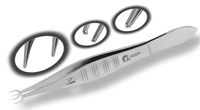Article
Device simplifies challenges of pterygium surgery
A new device ensures flap orientation during pterygium removals (Sabet Pterygium Flap Maintainer, Rhein Medical).

Key Points

The flap-maintaining device is designed to simplify pterygium surgery by ensuring the proper orientation of conjunctival grafts, and helping with the intraoperative management and manipulation of free conjunctival flaps.
This device was created by Sina J. Sabet, MD, a private practitioner here and assistant professor in the departments of ophthalmology and pathology at Georgetown University. Dr. Sabet's goal was twofold: to help practitioners with what can be a frustrating surgical procedure, and to save patients money by eliminating a trip to the operating room.
Reference point
"The problem with removing a free flap from the superior cojunctiva is that it becomes very difficult to manipulate," Dr. Sabet said. "You begin to lose orientation as to where the epithelial side of the conjunctiva is, where the stromal side is, and where the limbal side is. Basically, the flap loses its shape and it can be very frustrating to work with."
To solve this problem Dr. Sabet set out to create a device to maintain the orientation of the flap as it is being transposed from the superior conjunctiva. He started out with an instrument with three points of fixation, but soon discovered that he really needed only two. "A two-point fixation would always keep the epithelial side up. I always knew where the epithelium was, and I could clamp the two tips of this instrument over one edge, the forniceal side of the flap, and then as I transposed it I could always maintain orientation."
This device enabled Dr. Sabet to perform an increasing number of pterygium procedures in his office, without the need for even an operating microscope. "I can just give the patient a little oral sedative before the procedure and use my surgical loupes," Dr. Sabet said. "This device gives me the confidence to perform a pterygium removal and graft with the knowledge that I won't be wrestling with a free flap that had rolled up into a little ball."
Performing the procedure in his office not only is good for his practice, but it also saves patients a considerable amount of money compared with a trip to the operating room, Dr. Sabet noted. "The device makes it easier to suture the flap instead of using expensive surgical tissue glue," he said. "I'd estimate that I save patients $800 to $1,000 by using this device and performing the procedure in my office."
The flap-maintaining device presents a straightforward solution to a frustrating problem. Dr. Sabet said, "I've watched residents at hospital and, even though they were working with operating microscopes, they still had trouble maintaining an orientation on the flap.
"Even some very experienced surgeons would admit that they have wrestled with a flap that still ended up upside down, and they'd have to redo it. This simple device really helps eliminate that hassle," he concluded.
Newsletter
Don’t miss out—get Ophthalmology Times updates on the latest clinical advancements and expert interviews, straight to your inbox.




